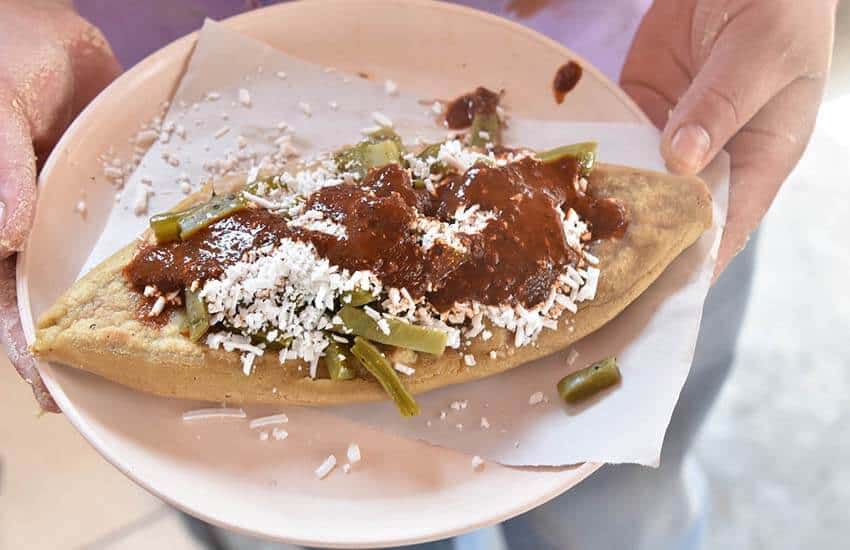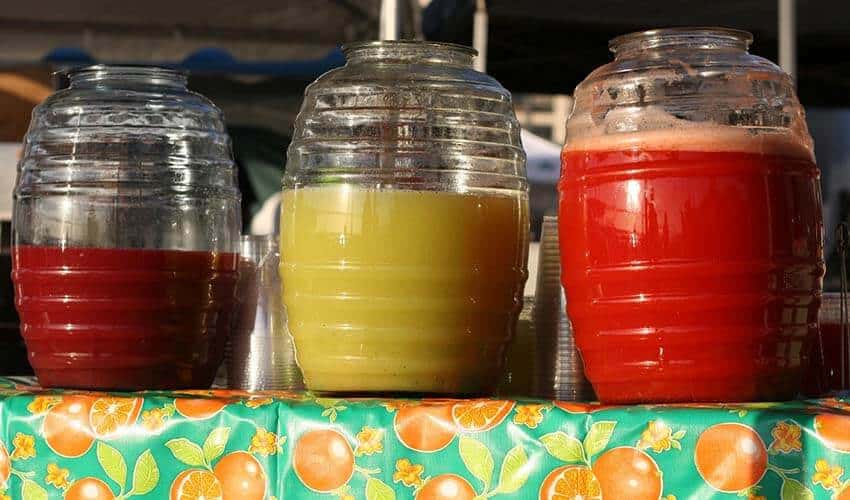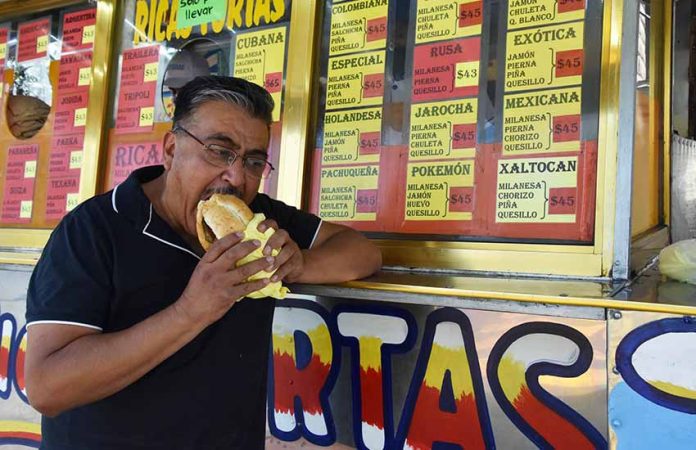When I made my first trip to Mexico — way back in 1997 — friends who had been there before warned me about eating street food.
They’d tell me horror stories about what happened to them or someone they knew when they ate food sold on the street, stories that were usually accompanied by overly colorful descriptions. I’m sure they were trying to be helpful, but they kept me from eating anything sold from a cart.
What a mistake.
Street food is really just homemade food that’s very tasty and extremely cheap. I now eat it pretty often and have never gotten sick.

Every pueblo and city in Mexico has people selling food from carts, small stands or baskets attached to their bicycles. There are also taquerías and even front rooms in homes that have been converted to tiny street food restaurants. There are lots of options, too many to cover in one article, but here’s a sampling.
Tamales: in the early morning, heavy three-wheeled bicycles loaded with silver containers jammed with tamales appear on corners in virtually every Mexican city and town. Tamales are masa (ground corn) stuffed with a variety of fillings and steamed in a corn husk.
My favorite is the rajas, made with queso fresco (a soft cheese), poblano chile and tomatoes. There’s also the sweet dulce tamal (singular is tamal and plural is tamales, by the way), and ones made with mole and verde (green) sauce. I always get my tamal as a sandwich — called a torta de tamal.
Pro tip: when you want tamales, get out early: the carts usually disappear by mid-morning.
Tlacoyos: masa filled with requesón (a soft cheese) or potatoes, molded into a triangle or oblong shape and cooked on a comal. In many places, they’re topped with nopales (sliced cactus) and grated cojita cheese.
Gorditas: the gorditas I’ve eaten in Mexico City are made from masa that’s been shaped into a large, thick circle. Cooks slice these, stuff them with whatever you want and cook them on a comal.
Not all gorditas are the same everywhere, though: I was surprised when the gordita I ordered in Puebla was more like a quesadilla — different but still good.
Molotes: a cross between fried dough and a calzone that I’ve only ever found in Puebla. Although I’m sure there are many ways to prepare them, the ones I’ve eaten — in the tiny front room of a house in Cholula — were made from dough that’s a mix of flour and corn and pressed until paper-thin.
Like gorditas, they’re filled with whatever you like, plus jalapeños and epazote leaves. They’re then deep-fried; probably not something to be eaten daily but man, are they good.
Quesadillas: large tortillas filled with whatever your heart desires. I’ve learned to always ask the vendor to add quesillo (Oaxaca cheese). In Milpa Alta (a borough of Mexico City), a popular version is one filled with sesos (brains), onions, jalapeños and epazote and then deep-fried.
Cemitas: another food I’ve only had in Puebla. A roll — called a cemita — is filled with meat, Oaxaca cheese, avocado and onions. There’s also a vegetarian version that’s piled high with cheese.
Tortas: on my second trip to Mexico in 1999, I came across a food stand in Mexico City that was selling tortas. Somehow, I concluded that a torta must be a small tortilla, so I asked for two, which was a mistake.

Although torta can refer to any kind of sandwich, in Mexico City they’re typically filled with meat, cheese, avocado, onion, refritos and mayonnaise and sold from small silver trailers. My favorite is torta suiza, which has three kinds of melted cheese. I always ask for chipotle salsa.
If you’re not hungry enough for a meal, there are plenty of types of botanas (snacks) available on the street:
Esquites: a simple snack made from fresh corn kernels that are either fried or boiled (I prefer fried). Both are usually served topped with cojita cheese, chile powder, mayonnaise and lime juice.
Chicharrón: slabs of deep-fried pork skin that are often seen hanging from hooks or simply placed on a table.
Cacahuates y chapulines: mobile vendors carry buckets of peanuts and fried grasshoppers throughout the streets. I’ve yet to try chapulines but my friends assure me they’re really good.
Papas: potatoes are sliced into hot oil, cooked for about three minutes, drained, cooled and stuffed in plastic bags. After my first taste, my days of buying bagged chips were over. Adding salsa, lime and salt to these is a must.
Need something to wash down all that food? Here are a bunch of choices:
Atole: during the winter, atole, a sweet drink made with corn masa, milk, piloncillo (raw sugar) and cinnamon is highly recommended. Atole made with rice instead of corn and with chocolate is also popular at tamal stands.
Chile Atole: a personal favorite. Masa is mixed with water and boiled along with corn kernels, chile (usually serrano) and epazote. Some cooks add radish leaves. This green, spicy drink’s usually only available in the colder months.
Tepache: also called pineapple wine, it’s a slightly alcoholic (about 2%) drink made from pineapple peels. It’s a deep reddish-brown drink that’s somehow able to taste sweet and vinegary at the same time. It’s served ice cold.
Cacao: known as tejate in Oaxaca and chilate in Guerrero, this cold, delicious chocolate drink is simply known as “cacao” in Santa María Tonantzintla, Puebla, where it’s made with cacao, toasted corn, amaranth and cinnamon.
The drink is stirred with a special, elaborately carved stick called a molinillo, which is spun between a person’s hands to give the cacao its froth.

Jugos: stands sell fruit and vegetable juices (fruit juices are called aguas frescas). They’ll often also sell horchata (a sweet rice drink) and jamaica (made from hibiscus flowers).
So now that you know a little about street food, you may be wondering what a meal will set you back. Prices will vary depending on the city or pueblo, but not by more than a few pesos.
A breakfast of a torta de tamal with a cup of atole costs around 21 pesos (US $1). For lunch, a tlacoyo and a cold glass of cacao will cost about US $3. Papas for an afternoon snack run around 18 pesos. If you’re adventurous, chapulines cost 30 pesos (US $1–$1.50).
Want a big dinner? Get a molote for 30 pesos, an order of nachos for another 30 pesos, 25 pesos for esquites and another 25 pesos for a liter of tepache, for under US $6.
Here is a recent Mexico News Daily article about what to watch out for with street food, or any food in general. Follow that advice, and you should be fine.
For what it’s worth, I’ve only had — well, let’s call it “intestinal distress” — three times in Mexico, and they all happened after I ate in a restaurant.
Provecho!
Joseph Sorrentino, a writer, photographer and author of the book San Gregorio Atlapulco: Cosmvisiones and of Stinky Island Tales: Some Stories from an Italian-American Childhood, is a regular contributor to Mexico News Daily. More examples of his photographs and links to other articles may be found at www.sorrentinophotography.com He currently lives in Chipilo, Puebla.
